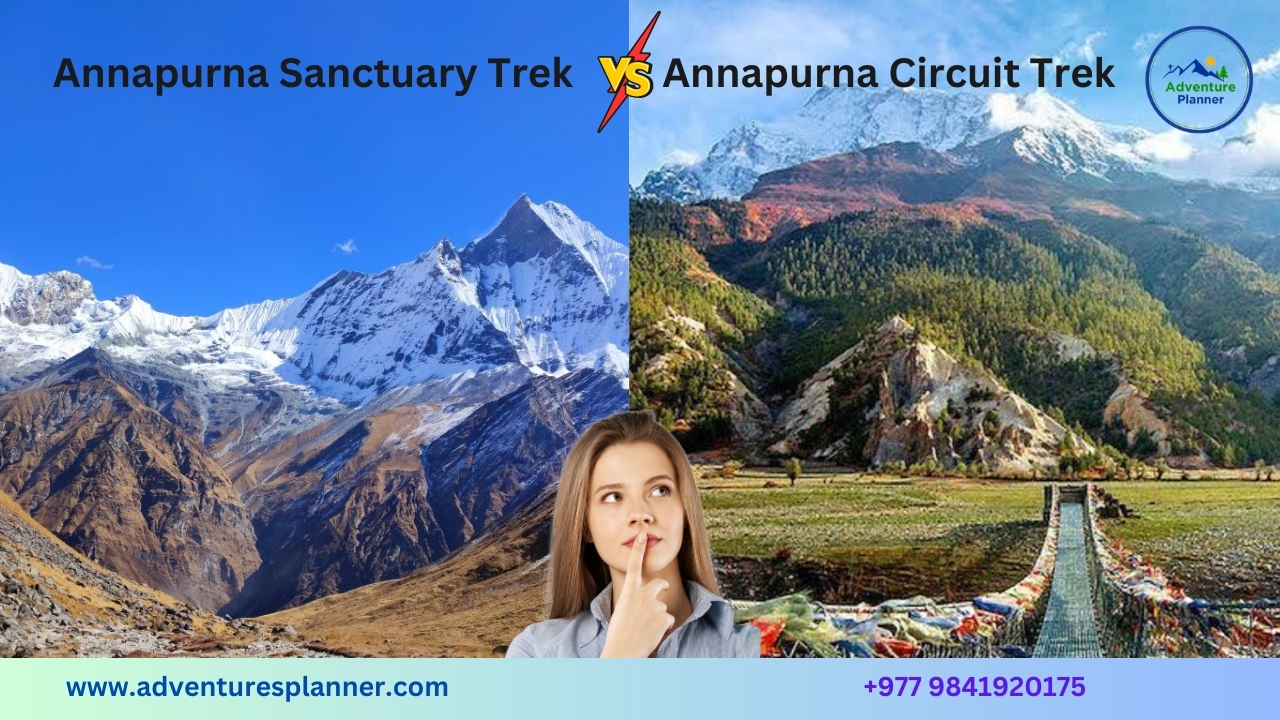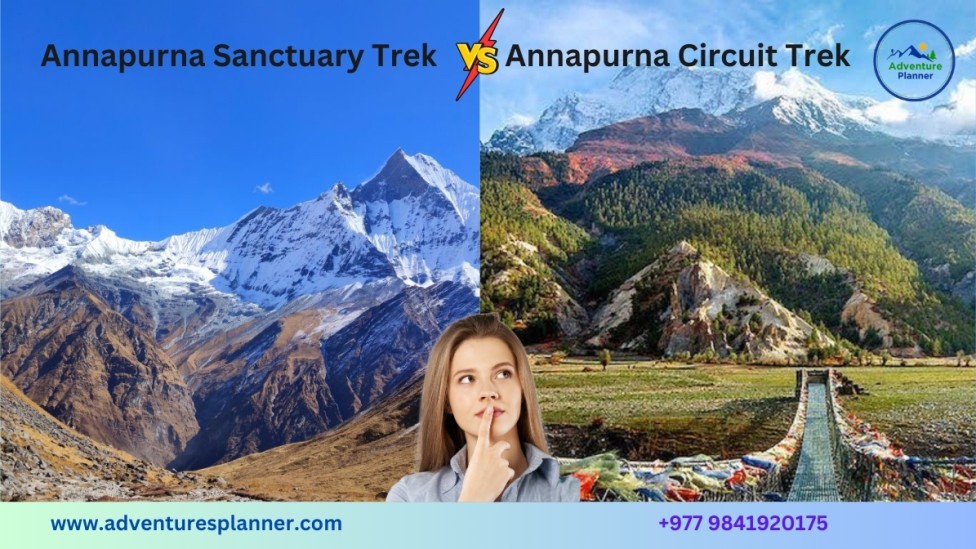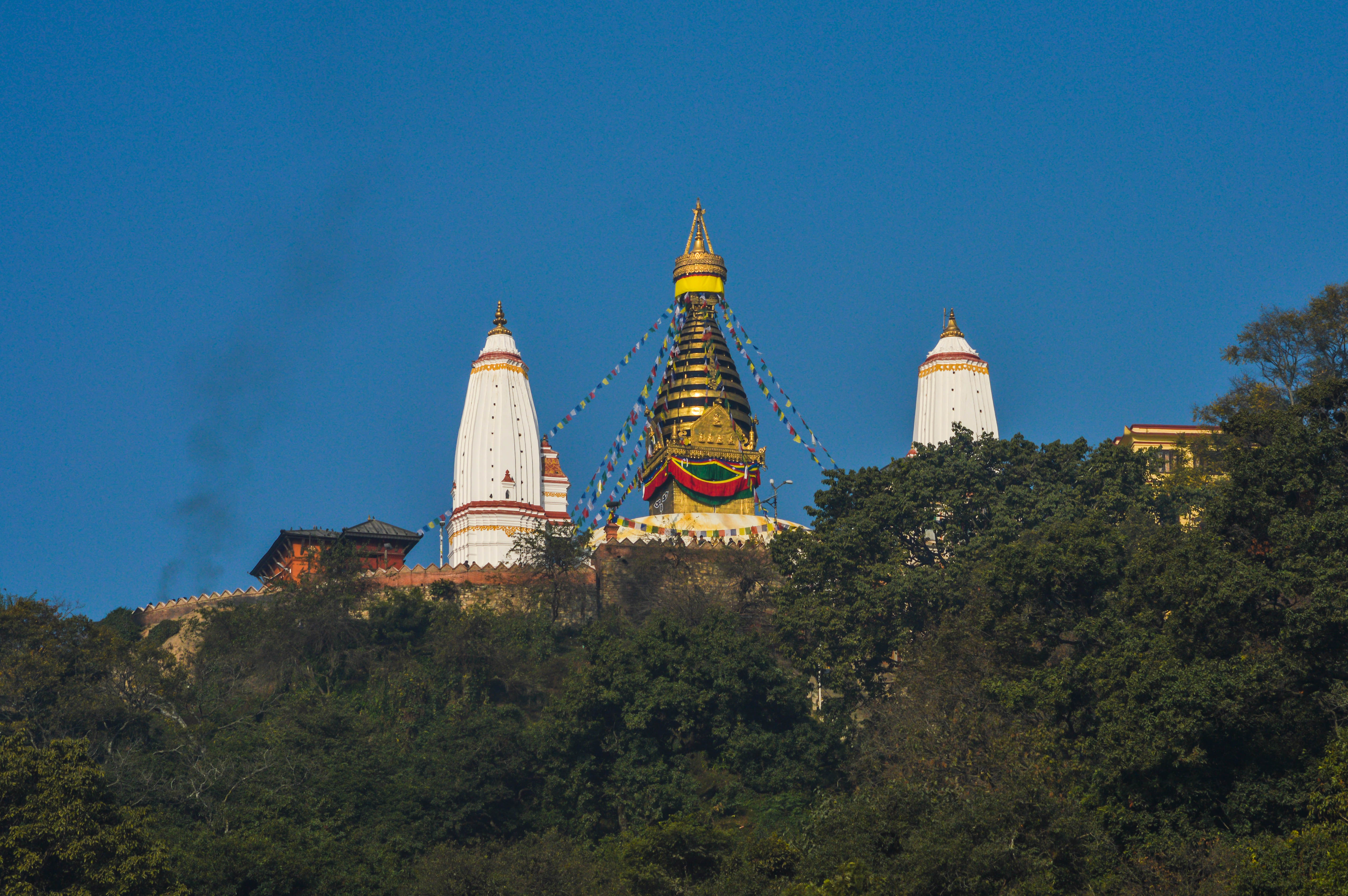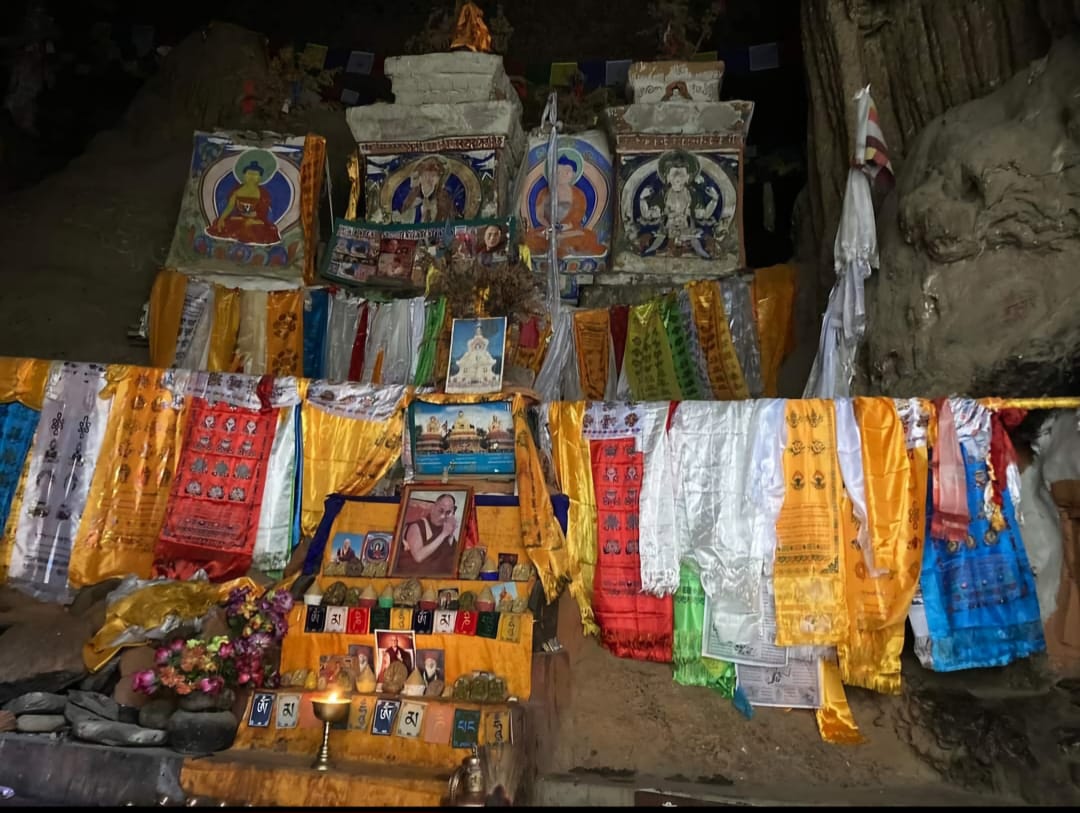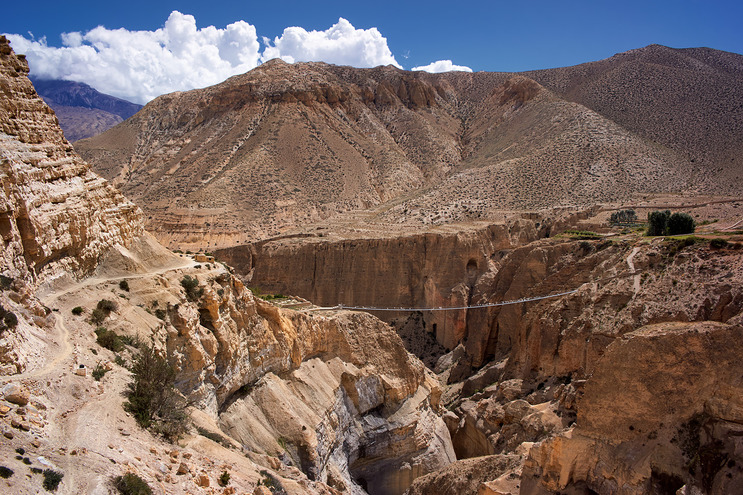Annapurna Sanctuary Trek and the Annapurna Circuit are popular trekking routes in Nepal. Still, they offer different experiences in terms of scenery, difficulty, and the kind of adventure they provide. Here’s a breakdown of both Trek Compare of Annapurna Sanctuary and Annapurna Circuit.
Annapurna Sanctuary Trek:
The Annapurna Sanctuary Trek is a popular trek that takes you to the iconic Annapurna Base Camp (ABC) in the heart of the Annapurna massif. Typically lasting between 7 to 12 days, this trek offers an accessible yet breathtaking experience, making it ideal for trekkers seeking a shorter, moderate challenge. The route provides close-up views of majestic peaks such as Annapurna South, Machapuchare (Fishtail), and Hiunchuli, and leads you through lush rhododendron forests, terraced fields, and traditional Gurung villages. With an altitude maxing out at 4,130 meters at ABC, it’s a trek that requires minimal acclimatization and is suitable for trekkers with moderate fitness levels. The Annapurna Sanctuary Trek is particularly famous for its scenic beauty, offering dramatic mountain vistas and a cultural experience that immerses you in the life of the local communities. It’s a perfect choice for those looking for a shorter, scenic trek with stunning mountain views without the challenges of high-altitude passes.
Key Highlights of the Annapurna Sanctuary Trek:
Stunning Mountain Views: You’ll see some of the highest peaks in the world, including Annapurna I, Machapuchare (Fishtail), and Hiunchuli. The trek brings you into close proximity to the Annapurna Sanctuary, which is a protected area surrounded by these towering peaks.
Diverse Landscapes: The trek begins in a subtropical zone, passing through lush forests with bamboo and rhododendron trees. You’ll pass through traditional villages and terraced fields before reaching the more barren and rugged high-altitude landscape as you get closer to the Sanctuary.
Cultural Experience: You'll have the opportunity to visit local villages inhabited by various ethnic groups, including the Gurung and Magar communities. These villages offer a glimpse into the local culture, architecture, and lifestyle.
The Annapurna Base Camp: The final destination of the trek is the Annapurna Base Camp (ABC), located at an elevation of 4,130 meters (13,550 feet). From here, you get incredible panoramic views of the Annapurna massif and the surrounding peaks.
Annapurna Circuit Trek:
The Annapurna Circuit Trek is one of the most renowned trekking routes in the world, offering trekkers an unforgettable journey around the entire Annapurna massif. This longer trek, ranging from 12 to 21 days, is renowned for its diverse landscapes, varying from lush subtropical forests to stark high-altitude deserts. The highlight of the trek is crossing the Thorong La Pass, one of the highest trekking passes in the world at 5,416 meters, which demands careful acclimatization. Along the way, trekkers are treated to stunning views of Annapurna, Dhaulagiri, and Manaslu mountains. The trek also offers a deep cultural immersion as it passes through a variety of ethnic villages, including Gurung, Thakali, and Tibetan communities, with stops at Muktinath, a sacred pilgrimage site. Known for its physical challenge, the Annapurna Circuit Trek is ideal for seasoned trekkers looking for an adventurous, high-altitude trek with cultural diversity and dramatic mountain views throughout.
Key Highlights of the Annapurna Circuit Trek:
Thorong La Pass: The highlight of the Annapurna Circuit Trek is crossing Thorong La Pass, which sits at an altitude of 5,416 meters (17,769 feet). It is a challenging pass but offers breathtaking panoramic views of the Annapurna and Dhaulagiri ranges.
Annapurna Massif: The trek takes you around the Annapurna mountain range, including Annapurna I, II, III, IV, Machapuchare (Fishtail), and Dhaulagiri, providing spectacular views at every turn.
Cultural Diversity: You'll pass through a variety of ethnic villages, including those inhabited by the Gurung, Thakali, and Manangi people. You’ll also get a chance to visit ancient monasteries, such as the Muktinath Temple and Buddhist stupas along the way.
Varied Landscapes: The trek takes you from subtropical forests, terraced fields, and traditional villages at lower altitudes to high-altitude deserts with barren, rocky landscapes as you approach the pass. It provides a range of scenery and environmental diversity.
Jomsom and Marpha: The trek passes through these famous places known for their apple orchards and traditional Tibetan culture. Marpha is especially famous for its apple brandy and picturesque views.
Trekking Difficulties: Compare Annapurna Sanctuary vs Annapurna Circuit
When comparing the trekking difficulties of the Annapurna Sanctuary Trek and the Annapurna Circuit, the key factors to consider are altitude, terrain, trek duration, and the technical challenges of the routes. Here's a detailed comparison of the difficulties:
Annapurna Sanctuary Trek Difficulties:
Altitude:
- The highest point is Annapurna Base Camp (ABC) at 4,130 meters.
- This trek does not involve any extreme altitude, so altitude sickness is less of a concern compared to other high-altitude treks.
- Altitude Gain is gradual as you make your way from lower altitudes (starting around 1,000–1,200 meters) up to base camp.
Trek Duration:
- Shorter trek, typically 7–12 days.
- Fewer days of trekking mean less overall physical fatigue, making it easier for trekkers to maintain stamina.
Terrain:
- Moderate terrain: The trail goes through rhododendron forests, terraced fields, and traditional villages.
- Some steep sections but generally well-maintained paths.
- No high-altitude passes to cross, so it's more about hiking along the valleys and up to the base camp.
Technical Difficulty:
- This trek is not technically demanding—there are no difficult climbs or exposed ridges.
- You don’t need any technical climbing skills, and it's primarily about stamina and acclimatization.
Difficulty Summary:
- Moderate difficulty: It’s a great option for trekkers who want to experience the Annapurna region’s beauty without facing extreme challenges. The altitude is manageable, and the trek duration is relatively short, making it more accessible.
Annapurna Circuit Trek Difficulties:
Altitude:
- The highest point is Thorong La Pass at 5,416 meters.
- The trek crosses high altitudes, which can increase the risk of altitude sickness. Proper acclimatization is crucial.
- The route involves significant elevation gain, especially when you climb up to Thorong La Pass.
- Higher altitude trekking means you must take care with acclimatization, which may increase the difficulty of the trek.
Trek Duration:
- Longer trek, typically 12–21 days.
- The longer duration adds to the overall difficulty since trekkers will need to endure daily trekking for a longer period, which can be physically taxing.
Terrain:
- More varied and challenging terrain: You’ll pass through subtropical forests, alpine meadows, high deserts, and rocky paths.
- The Annapurna Circuit involves crossing a high mountain pass (Thorong La), which is a challenging and often windy route, with some sections exposed to harsh weather conditions.
- The terrain can be difficult due to the long, strenuous daily walks and large elevation changes. Some sections, particularly near Thorong La, are rocky and can be steep.
Technical Difficulty:
- You won’t need technical climbing skills, but the altitude and the tough terrain of the Thorong La Pass present a significant challenge.
- Some sections can be physically demanding, especially the descent after crossing the pass (which can strain the knees and joints).
- Weather conditions (snow, rain, wind) at high altitudes can add to the challenge.
Difficulty Summary:
- Challenging difficulty: The Annapurna Circuit is a more difficult trek overall due to the higher altitudes, longer duration, and demanding terrain.
- The trek requires good physical conditioning, as well as proper acclimatization to handle the high-altitude sections and the Thorong La Pass.
- The altitude and extended trek duration increase the level of difficulty compared to the Annapurna Sanctuary Trek.
Side-by-Side Comparison of Trekking Difficulties of Annapurna Sanctuary vs Annapurna Circuit:
| Factor | Annapurna Sanctuary Trek | Annapurna Circuit |
|---|---|---|
| Highest Point | Annapurna Base Camp (4,130 meters) | Thorong La Pass (5,416 meters) |
| Altitude Risk | Low risk of altitude sickness | Higher risk of altitude sickness |
| Duration | 7–12 days | 12–21 days |
| Difficulty Level | Moderate | Challenging |
| Terrain | Moderate, forested paths, some steep sections | Varied, including rocky paths and steep ascents |
| Technical Difficulty | Easy, no technical climbing needed | Moderate, Thorong La Pass is physically demanding |
| Acclimatization Required | Minimal, gradual ascent | Essential, with time to adjust at higher altitudes |
| Overall Trek Difficulty | Moderate, accessible for most trekkers | Challenging, requires good fitness and stamina |
- Annapurna Sanctuary Trek is better suited for those who prefer a moderate, shorter trek with less technical difficulty and manageable altitude.
- Annapurna Circuit is best for those looking for a challenging, longer adventure that involves high-altitude trekking, demanding terrain, and the accomplishment of crossing the Thorong La Pass.
If you're new to trekking or want a less challenging experience, the Annapurna Sanctuary Trek would be a better fit. However, if you're seeking a more physically demanding trek with a sense of accomplishment, the Annapurna Circuit would be the way to go.
Why is Both the Annapurna Sanctuary and the Annapurna Circuit Famous for?
Both the Annapurna Sanctuary Trek and the Annapurna Circuit are famous for different reasons, and each offers a unique trekking experience in the Annapurna region of Nepal. Below is a comparison of what makes each trek famous and special:
Annapurna Sanctuary Trek – Why It's Famous For:
Annapurna Base Camp (ABC):
- The Annapurna Sanctuary Trek is primarily famous for taking trekkers to Annapurna Base Camp, one of the most iconic base camps in the Himalayas.
- The trek offers a close-up view of the Annapurna massif, including peaks like Annapurna South, Machapuchare (Fishtail), Hiunchuli, and Annapurna I. The panoramic view of the snow-capped peaks surrounding the base camp is breathtaking.
Accessible and Moderate Difficulty:
- It's one of the most accessible treks for trekkers of various experience levels. The trek doesn’t require technical skills or cross high-altitude passes, making it moderate in difficulty.
- With a shorter duration (typically 7-12 days), it’s a popular choice for trekkers who want to experience the Annapurna region but have limited time.
Scenic Beauty and Diverse Landscapes:
- The route passes through lush forests, gorges, terraced fields, and traditional Gurung villages, offering an immersive experience of rural Nepal.
- The rhododendron forests bloom in spring, adding extra beauty to the landscape, making it especially popular in the spring months.
Close-Up Mountain Views:
- The trek provides close views of towering mountains like Annapurna South, Machapuchare, and more, from relatively lower altitudes. This makes it ideal for photographers and those who want to witness stunning mountain vistas.
Cultural Experience:
- The Annapurna Sanctuary Trek passes through Gurung villages, allowing trekkers to immerse themselves in the local culture. The friendly people, traditional lifestyle, and Buddhist monasteries along the route enhance the cultural appeal.
Annapurna Circuit – Why It's Famous For:
Diverse Landscapes and Ecological Zones:
- The Annapurna Circuit is renowned for its diversity of landscapes. It takes trekkers through a range of ecosystems, from lush subtropical forests to high-altitude deserts, passing through green valleys, river valleys, and alpine meadows.
- This wide range of ecological zones allows trekkers to experience the transition from lowland to high-altitude environments, making it a more varied trek compared to the Annapurna Sanctuary.
Thorong La Pass – One of the Highest Trekking Passes:
- The Thorong La Pass (5,416 meters) is a key feature that makes the Annapurna Circuit famous. Crossing Thorong La Pass is one of the most challenging and rewarding parts of the trek, offering a sense of accomplishment.
- The pass itself provides spectacular views of the Annapurna and Dhaulagiri ranges. For many trekkers, it’s one of the main highlights of the entire trek.
Cultural Diversity:
- The Annapurna Circuit takes you through a variety of ethnic regions, such as Gurung, Thakali, and Tibetan communities. The trek offers a rich cultural experience as you pass through diverse villages, each with its own traditions, customs, and lifestyles.
- Muktinath, a sacred pilgrimage site for both Hindus and Buddhists, is a major spiritual highlight on the circuit, making it famous for its religious significance.
Crossing Multiple River Valleys:
- The circuit traverses the Marsyangdi River and the Kali Gandaki River, passing through several dramatic river valleys. The deep Kali Gandaki Gorge is considered one of the deepest gorges in the world, adding to the geographical fame of the trek.
Higher Altitude and Greater Challenge:
- The Annapurna Circuit is famous for being one of the best long-distance treks in the world due to its challenging nature—it requires more endurance, fitness, and acclimatization, particularly because of the Thorong La Pass.
- The trek’s length (12-21 days) and high-altitude environments make it a more adventurous and physically demanding trek.
Panoramic Views of Multiple Peaks:
- The Annapurna Circuit offers stunning panoramic views of the Annapurna, Dhaulagiri, and Manaslu ranges, as well as other peaks like Machapuchare (Fishtail) and Hiunchuli.
- The views of these majestic peaks from different points along the circuit make it a photographic and scenic masterpiece.
| Aspect | Annapurna Sanctuary Trek | Annapurna Circuit |
|---|---|---|
| Main Attraction | Annapurna Base Camp (ABC), close-up mountain views | Thorong La Pass, diverse landscapes, cultural diversity |
| Difficulty | Moderate (no high-altitude passes, shorter trek) | Challenging (longer trek, high-altitude pass) |
| Duration | 7–12 days | 12–21 days |
| Terrain | Lush forests, villages, some steep ascents | Varied terrain (subtropical to high-altitude desert) |
| Mountain Views | Close-up views of Annapurna South, Machapuchare | Panoramic views of Annapurna, Dhaulagiri, and Manaslu ranges |
| Cultural Experience | Traditional Gurung villages, local culture | Diverse ethnic groups (Gurung, Thakali, Tibetan), Muktinath pilgrimage |
| Altitude | Maximum: 4,130 meters at ABC | Maximum: 5,416 meters at Thorong La Pass |
| Famous for | Easy access to Annapurna Base Camp and mountain views | Diverse landscapes, crossing Thorong La Pass, cultural richness |
Summary:
Annapurna Sanctuary Trek is famous for offering an easier trek with close-up views of the Annapurna massif and Annapurna Base Camp, making it a great choice for those wanting a shorter, scenic trek with stunning mountain views and cultural immersion in Gurung villages.
Annapurna Circuit, on the other hand, is famous for being a longer, more challenging trek that offers a greater variety of landscapes and cultures. The Thorong La Pass and diverse ecosystems (from subtropical forests to alpine deserts) are major draws, as well as the opportunity to explore multiple river valleys and cross the deep Kali Gandaki Gorge. The trek also provides a chance to experience more of the Tibetan culture and visit the sacred Muktinath temple.
If you’re looking for a shorter, easier trek with great views and a focus on the Annapurna massif, the Annapurna Sanctuary Trek is the way to go. But if you want a longer, more varied trek with a greater challenge, the Annapurna Circuit will offer a more adventurous and diverse experience.
Conclusion: Annapurna Sanctuary vs Annapurna Circuit Trek
The Annapurna Sanctuary Trek is a shorter, moderate trek to Base Camp with stunning views, while the Annapurna Circuit is a longer, challenging route with diverse landscapes.
The Annapurna Sanctuary Trek is a relatively shorter and more accessible trek, usually completed in 7 to 12 days. It focuses on reaching the famous Annapurna Base Camp (ABC), offering trekkers close-up views of towering peaks such as Annapurna South, Machapuchare (Fishtail), and Hiunchuli. The route primarily passes through lush rhododendron forests, terraced fields, and traditional Gurung villages, providing a great opportunity for cultural immersion in local communities. With a maximum altitude of 4,130 meters, the trek is considered moderate in difficulty and does not involve high-altitude passes, making it suitable for trekkers with average fitness levels. This trek is perfect for those looking for a shorter, scenic adventure that combines stunning mountain vistas with a manageable difficulty level.
On the other hand, the Annapurna Circuit Trek is much longer and more challenging, typically taking 12 to 21 days to complete. It is famous for its diverse ecosystems, ranging from subtropical forests to high-desert terrain, and its dramatic changes in altitude, including the crossing of the Thorong La Pass at 5,416 meters—one of the highest trekking passes in the world. This trek offers panoramic views of some of the world’s most stunning mountain ranges, such as Annapurna, Dhaulagiri, and Manaslu. The Circuit also offers a deep cultural experience, passing through several ethnic villages, including Gurung, Thakali, and Tibetan communities, and allowing trekkers to visit Muktinath, a sacred Hindu and Buddhist temple. Due to its higher altitude and longer duration, the Annapurna Circuit Trek is best suited for experienced trekkers looking for a more demanding, adventurous trek with the added challenge of high-altitude passes and a variety of landscapes and cultures.
Comparison: Annapurna Sanctuary Trek vs Annapurna Circuit Trek
| Feature | Annapurna Sanctuary Trek | Annapurna Circuit |
|---|---|---|
| Duration | Shorter (7–12 days) | Longer (12–21 days) |
| Altitude | Max altitude: 4,130 m (ABC) | Max altitude: 5,416 m (Thorong La Pass) |
| Difficulty | Moderate | Challenging due to long distance and high pass |
| Terrain | Lush forests, valleys, close views of peaks | Diverse: subtropical to alpine desert |
| Main Attraction | Annapurna Base Camp (Sanctuary) | Thorong La Pass, diverse ecosystems |
| Best For | Those wanting a shorter trek with stunning views | Those seeking a longer, more diverse trek |
| Cultural Experience | Gurung villages and Annapurna region culture | Rich cultural diversity (Gurung, Thakali, Tibetan) |
| Popular for | Scenic beauty and base camp experience | High-altitude adventure and variety of landscapes |
Which Trek Should You Choose ( Annapurna Sanctuary vs Annapurna Circuit) ?
- Annapurna Sanctuary Trek is ideal if you have limited time and want to enjoy a more straightforward, scenic trek with beautiful mountain views and a great experience of the Annapurna region without dealing with high-altitude passes.
- Annapurna Circuit is better for those seeking a more challenging, extended trek with diverse landscapes, higher altitudes, and a sense of achievement from crossing Thorong La Pass.
In summary, The Annapurna Sanctuary Trek and the Annapurna Circuit Trek offer distinct trekking experiences in Nepal. The Annapurna Sanctuary Trek is a shorter, moderate trek that typically lasts 7-12 days, taking trekkers to Annapurna Base Camp (ABC). With a maximum altitude of 4,130 meters, it offers stunning views of the Annapurna massif, including Annapurna South and Machapuchare (Fishtail), while passing through lush forests and traditional Gurung villages. It’s ideal for trekkers seeking scenic beauty and a relatively easy trek.
In contrast, the Annapurna Circuit Trek is longer and more challenging, taking 12-21 days to complete. The trek crosses the Thorong La Pass at 5,416 meters and passes through diverse ecosystems, offering breathtaking views of Dhaulagiri, Annapurna, and Manaslu. Along the route, trekkers experience a mix of ethnic cultures and visit sacred sites like Muktinath. It’s best suited for experienced trekkers seeking an adventurous, high-altitude challenge.
